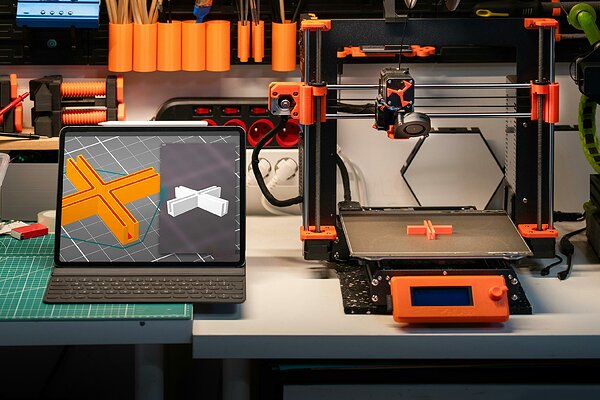In 3D printing, transforming a digital design into a physical object involves many important steps, with file formats being a key part of the process. The formats act as instructions to your software in order to interpret the key aspects of your designs. Knowing which file formats to use is important because it affects the quality of your final object!
The various file formats play a key role during the design and file storing process and not so much in the printing process since 3D printers usually require a format named G-code to operate. These initial file formats, such as STL and OBJ, are critical because they serve as the blueprint from which the 3D object is created. They contain essential information about the object's geometry, texture, and sometimes color, which are important for visualizing and editing the design in 3D modeling software.
Furthermore, these formats allow for a level of detail and refinement that directly impacts the quality of the final print. Before the printing begins, slicing software takes these detailed files and processes them, deciding on the print's structure, layer height, and material distribution. It's during this slicing phase that the model is transformed into G-code.
The G-code itself is a set of instructions tailored for the specific printer, dictating every movement, speed, and action needed to realize the design physically. However, without the initial detailed information from formats like STL or OBJ, the slicer wouldn't be able to accurately create these instructions. Therefore, while the 3D printer operates on G-code, the earlier file formats are responsible for shaping and detailing the 3D model, determining the fidelity of the printed object.
Common 3D printing file formats
In 3D printing workflows, several file formats are commonly used, each serving a unique role in turning digital models into printed objects. The most commonly used among these are STL, OBJ, AMF, and 3MF. Each format varies in the way it encodes information about the model's geometry, texture, and other properties. Understanding the distinct characteristics of these file formats is crucial for anyone involved in 3D printing, as the choice of format can significantly impact your workflow and outcome of the print.
What type of files does a 3D printer use?
When it comes to the actual printing process, 3D printers use a type of file known as G-code. This file format is crucial because it contains the specific instructions that guide the printer on how to create the object. It tells the printer where to move, how fast to go, and what path to follow, layer by layer.
However, before we get to G-code, other file formats play important roles in the earlier stages of the 3D printing workflow. Formats like STL, OBJ, AMF, and 3MF are used to design and prepare the models. These files hold information about the shape and details of the object you want to print. They are created in 3D modeling software and then transformed into G-code by a piece of software called a slicer. This slicer takes the model and slices it into layers, translating it into the G-code that the printer will understand.
In summary, while G-code is what the 3D printer ultimately uses, other file formats are vital in the steps leading up to the final printing stage. They allow for the creation, customization, and preparation of the model before it becomes the G-code that guides the 3D printer.
.STL - The most commonly used format
STL format, short for Stereolithography, is often considered the backbone of 3D printing. It is the most popular and widely adopted file format in the 3D printing world. Known for its simplicity and compatibility, STL has become the default choice for a vast range of 3D printing projects, from basic prototypes to complex models. Its compatibility across different 3D printing software and hardware makes it a familiar and reliable option for both beginners and seasoned professionals in the field.
What is an .STL file?
It is a 3D file format that represents three-dimensional objects using a series of triangular facets, which approximate the surfaces of the object. This format has become a standard in the 3D printing industry due to its straightforward approach to modeling objects geometrically.
STL files focus on the surface geometry of a model without including information about color, texture, or material. Essentially, they describe the shape of an object using a mesh of triangles, which is why they are widely used for 3D printing. The simplicity of the STL format makes it universally compatible with almost all 3D printers and a safe choice for ensuring successful prints.
Other key 3D printing file formats
While STL files are a standard in 3D printing, there are several other important file formats as well. Each of these formats has its own special features and uses, making them suitable for different kinds of 3D modeling and printing tasks. It's important to know about these formats if you want to get the most out of 3D printing, especially for more complex and detailed projects.
These are some other popular formats found in 3D printing workflows:
OBJ: This is another popular format. It's a bit like STL but can store more information. For example, OBJ files can keep details about the texture and color of your model. This makes them great for designs where how the surface looks is important.
AMF: Standing for Additive Manufacturing File, this format is like a more advanced version of STL. It can store more detailed information about your design, including colors and materials. AMF files can describe different parts of your model with different properties, like color or material.
3MF: Developed as a more modern alternative, the 3MF format can store even more information than AMF. It's designed to include everything a printer might need to know, from colors and materials to more specific printer instructions. This format is trying to become the new standard for 3D printing files.
Each of these formats has its own strengths, and the best one for you depends on what you need for your project. OBJ is widely used and supported, making it a good all-around choice. AMF and 3MF offer more detailed options for complex projects. In the following sections, we'll dive deeper into each of these formats to help you understand when and why you might choose one over the others.
Converting and preparing files for printing
This stage is where your 3D model originally created in OBJ or STL gets transformed into G-code - a file that your 3D printer can understand and print. Preparing a 3D model for printing though goes before just conversion. It can be a step where you revisit your created or downloaded model to make adjustments and edits with the goal of optimizing it for the printing process. This can be tweaking its dimensions, adjusting it to ensure structural integrity or adding specific elements like supports. In this section we will elaborate on the edits that you can do to your model before converting it to G-code, as well as the G-code conversion process.
After fine-tuning your 3D model, the next key step is converting the STL file into G-code, the specific language that 3D printers understand and follow. This process involves using slicing software to interpret the STL file and convert it into a series of precise instructions for the printer. It dictates everything from layer height to print speed, ensuring that each slice of your model is accurately printed. We've covered this conversion process in detail before, particularly focusing on how to use Cura, a popular slicing software, for this purpose. Understanding this conversion is crucial, as it directly affects the quality and accuracy of your final printed object. Having converted your 3D model, whether in OBJ or STL format, into G-code marks the final step in preparing your files for printing.
As we conclude our exploration of file formats in 3D printing, we’ve seen the role they play from the initial design phase to the final G-code conversion. Each format offers unique benefits and challenges making them suitable for different aspects of 3D design and printing. Understanding these formats and mastering the conversion to G-code is essential for successful printing results. Stay tuned for our upcoming guides, where we’ll dive deeper into the world of 3D printers, exploring their functionalities and answering the most common questions about them, as well as other 3D printing related topics and advancements.





Comments